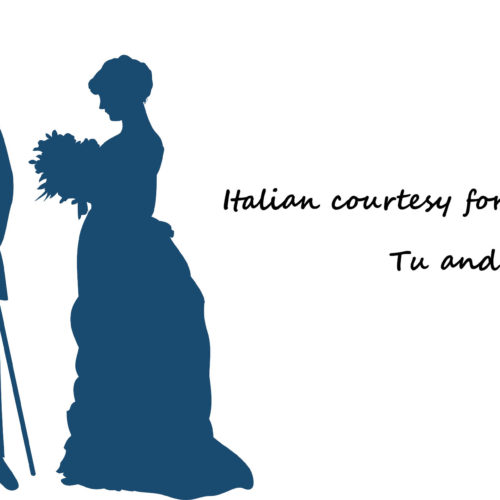A verb is an action word and a variable part of speech that depends on four elements:
- Subject
- Tense
- Mood
- Conjugations
- Subject: Refers to the person (first, second, third, singular and plural).
- Tense: Reflects whether the action is taking place in the past, present or future. For example: “I’m eating the apple” or “I ate the apple” (“Io mangio la mela” or “Io mangiai la mela”).
- Conjugation: The correct conjugation of a verb is required to express the tense.
- Mood or Manner of Being: A verb inflection expressing how the action or state is conceived by the speaker and if the verb is transitive (requires a direct object) or intransitive (does not take an object; has only one argument, its subject).
In this article we will be concentrating on mood and conjugations as they apply to verbs in Italian.
Mood
Mood refers to the position or attitude that a speaker has to what is being written or spoken. A verb may be in three moods:
-
Indicative mood is used to make a statement (ie: “I’m a girl” or “Sono una ragazza”),it expresses a fact or opinion, or to ask a question. This is the most common verb mood. Another example is “Gianni closes the door” or “Gianni ha chiuso la porta.”
-
To give an order or make a request one uses the imperative mood (ie: “Close the door” or “Chiudi la porta.”)
-
The subjunctive mood is the rarest of the three, although it is used more often in Italian that in English. The subjunctive mood is used to express hope, fear, possibility and doubt and mainly in sentences with dependent clauses introduced by “che” (that is, sentences introduced by a conjunction that do not have a fully formed meaning.) In English the present tense subjunctive is formed by removing the “s” from the third person singular verb, except in the case of the verb “be.” An example of a subjective mood verb in English is the expression “God save the Queen.”
The Italian subjunctive has four forms, these include the simple tenses present subjunctive (congiuntivo presente) and imperfect subjunctive (congiuntivo imperfetto), and the compound tenses perfect past subjunctive (congiuntivo passato) and pluperfect (congiuntivo trapassato), which are made using an auxiliary verb added to the past participle of the main verb.
A closer look at the subjunctive:
-
Present Subjunctive of regular verbs is reached by dropping the original endings to add a new ending like “-iamo” for a verb that originally ends in “-i.” ie: “parli” = “parliamo”
-
Imperfect Subjunctive is used when the action in a sentence is uncertain. You add a personal ending to the imperfect root of the word, for example adding “-essero” to “avere” when the verb refers to a group. ie: “Credevo che avessero ragione” = “I thought they were right.”
-
Perfect Past Subjunctive requires an auxiliary verb (“essere” for intransitive or reflexive verbs and “avere” for transitory verbs) to add to the past participle of the verb in question. This is, effectively, a compound tense. ie: “Non credo che siano andati a Roma” = “I don’t believe they went to Rome.” In this case “siano” is the auxiliary, a form of “essere.”
-
Pluperfect is similar to the perfect past subjunctive, except that in this case you use the congiuntivo imperfetto of “avere” or “essere” paired with the past participle of the acting verb. ie: “Speravo che fossero andati” = “I was hoping they had gone.”
Conjugations
In Italian verbs are classified into three conjugations: are – ere – ire. For example:
Cammin-are I conj. (“walk”)
Tem-ere II conj. (“fear”)
Sent-ire III conj. (“to feel” or “to hear”)
Every change to the verb depends on the mood, the tense, the person and the conjungation. One part that doesn’t change, that is invariable, is the stem of the word. It is the ending that is variable. For example:
Lod (root-stem)-iamo(ending)= lodiamo (“to praise”)
Rid(stem)-evano(ending) = ridevano (“they laughed”)
The genre of the verb indicates whether the subject of the verb is male or female. The endings are also different depending on whether they are singular or plural. Masculine/maschile words have “o” or “i” endings, while female/femminile words have “a” or “e” endings. For example:
Il libro (masculine singular); I libri (masculine plural) = The book; the books
La mela (feminine singular), Le mele (feminine plural) = The apple; the apples
The action of a transitive verb requires a direct object, something or someone who receives the action of the verb to complete the meaning. For example:
Carlo colpì Claudio sul viso = Carlo kicked Claudio in the face
Carlo (subject) + kicked ( transitive verb) + Claudio(direct object)
A verb that doesn’t take an object is called intransitive, there is no word in the sentence that tells who or what received the action. For example:
Il sole brucia = The sun burns or Ha nevicato = It snowed
All verbs used in a transitive manner require the auxiliary HAVE (“avere”) in compound tenses, while many intransitive verbs and all reflexive verbs require BE (“essere”) as the auxiliary in compound tenses. The auxiliary verb “essere” is therefore required for compound tenses, especially in the case of intransitive and impersonal verbs and with reflexive verbs.
The most important “tenses” in Italian are il Presente (Present), il Passato (Past) and il Futuro (Future). Presente expresses the period of time that is happening now or any continuous stretch of time including the moment of speech (ie: “Loro suonano il campanello” = “They ring the bell.”) Passato expresses an action that is finished, that was in the past and doesn’t exist any longer, and has five different forms (l’Imperfetto, Il Passato Prossimo, il Passato Remoto, il Trapassato Remoto, Il Trapassato Remoto.) An example of the passato tense is “L’anno scorso andai in China,” which means “Last year I went to China.” Lastly, Imperfetto expresses a verb tense used in describing action that is on going or an action that began in the past and has an unsure duration or beginning (ie: “Avevo sete” = “I was thirsty.”)
Passato Prossimo (Present Perfect) is essentially a present tense, but it also expresses the effect of past actions and activities on the present (ie: “Nella mia vita ho viaggiato in tutti i cinque continenti = “In my life I have travelled to all five continents.”) The Passato Remoto (Past Simple) is used to express a finished action in the past and is also used to express actions that follow each other in a story (ie: “Maria entrò nella stanza e si fermò, ascoltò attentamente e sentì un rumore venire da dietro la tenda. Tirò la tenda e lei vide…” = “Maria entered the room and stopped. She listened carefully. She heard a noise coming from behind the curtain. Maria opened the curtain and saw…”)
Trapassato Remoto (Past Perfect) refers to an action in the past that was completed before another action in the past (ie: “Quando arrivai a casa trovai che qualcuno era entrato nel mio appartamento e aveva rubato i miei gioielli” = “When I got home, I found that someone had broken into my flat and had stolen my jewellery.”) Trapassato Prossimo (Pluperfect) is used where the consequence of some event is associated with the event during a Past Tense narration (ie: “She only started learning to speak Italian after she had heard Vasco Rossi sing” = “Ella iniziò solo ad imparare l’italiano dopo aver ascoltato la canzone di Vasco Rossi.”)
Futuro (Future) is a verb tense that expresses actions or states in the future. For example, “io sarò” is Fututo Semplice while “sarò stato” is Futuro Anteriore (Future Perfect).
Conditional (Condizionale) conjugation is used to express a possible condition and a probable result. For example:
“Attenzione! Se tu lo tocchi, ti brucerai!” = “Careful! If you touch that, you’ll burn yourself!”
“Se Franco smetesse di fumare, potrebbe correre più veloce” = “If Franco stopped smoking, he could run faster.”
L’Imperativo (Imperative) expresses a command, advice or an intention to influence the listener’s behavior. For example:
“Vieni qui, per favore!” = “Come here, please!”
“Stai attento!” = “Be careful!”
L’Infinito (Infinite) expresses the verb that has no person or quantity. It has two tenses: Present (ie: sognare = dream) , and Past (ie: aver sognato = dreamed).
Il Participio (Participle) is very close to the adjective and the noun and owes its name to the fact that it takes part in these categories. It also has two senses as seen above with l’infinito.
Il Gerundio (Gerund) is a tense that expresses an action in progress . It can also have a Present and a Past tense. (ie: mangi-ando, legg-endo, sbagli-ando = eating, reading, erring).
Exercise
Conjugate the verbs…
1) Noi (visitare) i nostri amici a Londra la prossima settimana = We are visiting our friends in London next week.
2) Che colore tu (dipingere) la vostra camera? = What color are you going to paint your room?
3) Io solitamente (indossare) jeans e maglie nel mio tempo libero = I usually wear jeans and sweaters during my down time.
4) (Vedere) qualche buon film recentemente? = Have you seen any good films recently?
5) Io (incontrare) Maurizio a Londra l’altra settimana = I met Maurizio in London last week.
6) Se vedo Carlo stasera, io lo (invitare) alla festa = If I see Carlo this evening I’ll invite him to the party.
Answers: Visiteremo, dipingerai, indosso, hai visto, ho incontrato, inviterò.
By Elisa Bressan





































